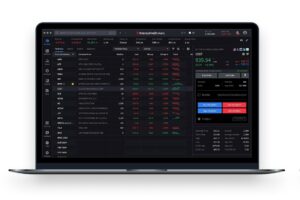At the end of Friday, the Dow Jones (US30) fell by 0.70% (-1.39% for the week). The S&P 500 Index (US500) was down 1.23% (for the week -2.30%). The Nasdaq Technology Index (US100) was down 2.40% (-3.67% for the week). Wall Street saw a sharp decline on Friday as investors evaluated Fed Chair Powell’s remarks. Fed Chair Powell’s hawkish stance on interest rates pressured the market as he emphasized the strength of the economy, a robust labor market, and steady inflation, which led to lower expectations for a rate cut. The Fed’s hawkish comments lowered the odds of a Fed rate cut next month to 55% from 82% a day earlier. US retail sales in October exceeded estimates, rising by 0.4%. The technology sector suffered significant losses, with major companies such as Nvidia, Amazon, Meta, and Alphabet falling by more than 2%. The pharmaceutical sector also came under pressure due to news that Trump may nominate vaccine skeptic Robert F. Kennedy Jr. to head the Department of Health and Human Services.
The Dollar Index held near 106.6 on Monday, trading near two-year highs amid expectations of Federal Reserve interest rate cuts and bets on US economic growth under a Trump presidency. Last week, Fed Chairman Jerome Powell said the Central Bank has no immediate plans to cut rates, citing the strength of the economy, a stable labor market, and continued inflationary pressures. Stronger-than-expected reports on retail sales and inflation supported hawkish views on Fed policy. Markets rate the odds of a 25 bps rate cut at the December 17–18 FOMC meeting as 55%.
Pfizer (PFE) shares are down more than 3% after Wolfe Research initiated coverage on the stock with an “underperform” recommendation and a $25 price target. Palantir (PLTR) is up more than 9%, leading gains in S&P 500 stocks after the company said its listing on the New York Stock Exchange will close at the close of trading on November 25, with trading on the Nasdaq beginning the following day.
Equity markets in Europe were declining on Friday. Germany’s DAX (DE40) fell by 0.27% (week ended -0.91%), France’s CAC 40 (FR40) closed down 0.58% (week ended -1.70%), Spain’s IBEX 35 (ES35) gained 0.97% (week ended -0.03%), and the UK’s FTSE 100 (UK100) closed down 0.09% (week ended -0.11%) on Friday. The European Commission’s Fall 2024 estimates call for the Eurozone economy to grow by 0.8% this year, the same as the previous Spring prognosis. Growth estimates for 2025 have been revised downward to 1.3% from 1.4%, and for 2026, the euro area economy is predicted to grow by 1.6%. As for inflation, despite a small rise in October, mainly driven by energy prices, core inflation in the Eurozone will more than halve to 2.4% in 2024 from 5.4% in 2023 and then gradually decline to 2.1% in 2025 and 1.9% in 2026.
WTI crude oil prices rose above $67 a barrel on Monday, pausing a recent decline, as the escalating conflict between Russia and Ukraine raised concerns about possible supply disruptions. Over the weekend, Russia launched its largest airstrike on Ukraine in nearly three months, further undermining an already crippled energy system. Meanwhile, concerns about weakening demand in China, the world’s largest oil importer, contributed to the bearish market sentiment. In addition, downward pressure on prices is exerted by the strengthening of the US dollar, supported by expectations of a slowdown in the pace of rate cuts by the Federal Reserve.
Asian markets were mostly declining last week. Japan’s Nikkei 225 (JP225) decreased by 1.96%, China’s FTSE China A50 (CHA50) fell by 2.40%, Hong Kong’s Hang Seng (HK50) lost 4.11%, and Australia’s ASX 200 (AU200) was negative 0.16%.
The offshore yuan weakened to 7.24 per dollar, back to its lowest level in more than three months, as investors await a decision on China’s marginal lending rate this week. Markets expect the People’s Bank of China to keep the one-year and five-year LPR rates at 3.1 percent and 3.6 percent, respectively. Last week, investors reacted to mixed economic data indicating that Beijing’s stimulus measures may not yet be yielding the expected results.
The Australian dollar stabilized above $0.645 on Monday, supported by a hawkish view on the Reserve Bank of Australia’s (RBA) monetary policy. Last week, RBA Governor Michele Bullock said that interest rates are quite restrictive and will remain at current levels until the Central Bank is confident about the inflation outlook. Investors are awaiting the release of the minutes of the latest RBA meeting this week for further guidance on the Central Bank’s policy direction.









